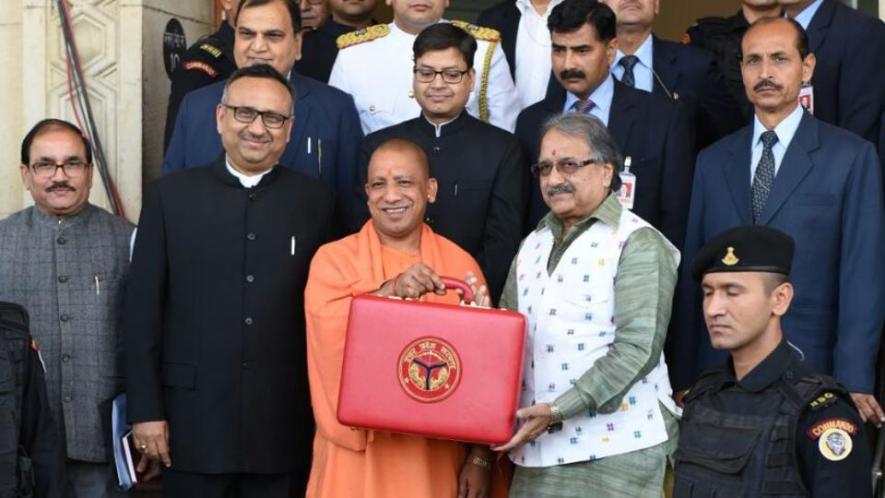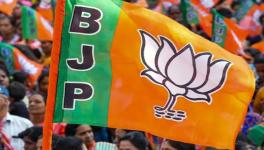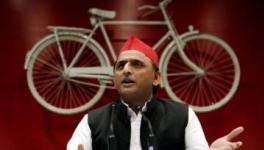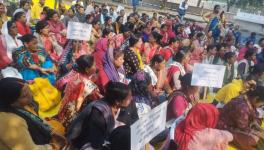UP Budget: Farmers and Marginalised Sections Neglected

Image Courtesy: Hindustan Times
The State government allocated Rs. 63,223 crores for overall Education sector which is an increase of 10.90% as compared to 2017-18 in which Rs. 56,993 crores were allocated. Out of this amount, Rs. 50,142 crore will be spent on Primary Education, Rs. 9,387 crore on secondary education and Rs. 2,656 on higher education. But UP's budget allocation for Education is lower than the money allocated by 18 other states for education.
According to an analysis done by the PRS Legislative, a group which monitors and analyses framing of policies and laws, UP allocated 14.5% of its total budget on education in 2018-19. This is lower than average expenditure allocated to education by 18 other states which is 16.1%. The eighteen other States whose budget the PRS Legislative compared to that of UP are Andhra Pradesh, Assam, Bihar, Delhi, Chhattisgarh, Gujarat, Haryana, Jammu and Kashmir, Karnataka, Kerala, Maharashtra, Madhya Pradesh, Odisha, Punjab, Rajasthan, Tamil Nadu, Telangana and West Bengal.
Only in the domain of rural development and health UP's allocation is slightly higher than the average of funds allocated by 18 States. While for rural development, UP allocated 5.9% of its total budget, the rest of the 18 states allocated 5.6%.
The edge in allocation for health by UP is only that of 0.7% as compared to other states. While UP spent 5.5% of its total budget for health, rest of the states allocated 4.8% of their total budget.
UP allocated Rs. 32,019 crore for the department of social welfare which is a very minor increase of 2.40% as compared to last year's budget in which Rs. 31,278 crore was allocated for the department by the State.
The Department of Energy's budget allocation by the UP government has gone from Rs. 18,061 crores in the year 2017-18 to Rs. 27,575 crores which is an increase of 52.70%. But the largest chunk of this amount (62%) will go for revenue expenses such as payment of interest and subsidy and 38% of this amount is capital expenses.
While the BJP government set the target of generating 10,700 MW of power using solar energy by 2022 but it allocated only Rs. 25 crore. A solar street light scheme dedicated to the ruling party ideologue Deen Dayal Upadhyaya, got Rs. 30 crore.
The Yogi Adityanath government allocated Rs. 19,733 crore for rural development which is an increase of 23.70% from last year's budget allocation of Rs. 15,949 crores. Out of this Rs. 2,923 crores will be spent on roads and bridges and Rs. 1,166 crore on housing.
The department of medical and public health got Rs. 20,157 crores which is an increase of 19.70% from the allocation in 2017-18 which was Rs. 16,839 crore.
The most important announcement of this department was introduction of Private sector in public health. The government announced that 170 national mobile medical units will be set up through the Public-Private-Partnership (PPP) model. The State government failed to think of major enhancement of the government hospitals at district level and instead chose to enhance select few hospitals. For instance, it announced that a 500-bed super specialty hospital and paramedical and nursing college will be set up at the Dr. Ram Manohar Lohia Institute of Medical Sciences in Lucknow.
When the situation of normal hospital is abysmal, the BJP government chose to invest in Ayurveda and announced to set up 100 new Ayurvedic hospitals across the state.
The budget for a crucial department like Urban Development saw an increase of mere 2.60% in allocation of money as compared to last year’s budget. The government increased the budget allocation from last year's Rs. 13,144 crores to Rs. 13,484 crores out of which Rs. 1,650 crores has been allocated for Smart Cities programme.
But the most important story from the Yogi Adityanath's budget was for farmers. The State government decreased the allocation for Agriculture by 59.20 % on the pretext that it implemented the farm loan waiver. While the government had allocated Rs. 28,387 crore in 2017-18 for Agriculture in 2018-19 the budget allocation went down to Rs. 11,589 crore.
The government spokespersons tried to explain this major cut by saying that the state government had implemented Rs. 35,000 crore farm loan waiver package last year the overall spending of Agriculture was much more but many activists question the logic of decreasing the budget by more than fifty percent for a sector which is struggling and going through a stage of continuous crisis involving increasing input cost, decreasing extent of recovering of the investment and farmers suicide among many others.
If one were to look at Yogi Adityanath's budget from the perspective of workers, dalits, women, Adivasis, and backward groups, it turns out that the slogan of “Sabka Saath, Sabka Vikas” is a mere rhetoric for elections. The government's policies in the budget has nothing to offer to the marginalised, underprivileged and the poor sections of society which constitute the largest chunk of the society and for whom it is a daily fight for survival to make ends meet.
A detailed analysis of the budget of eight departments done by Delhi Solidarity Group, (DSG) a collective of Non Governmental Oganisations working on Dalits, Adivasis, backward, poor and minorities, points out three major take away from the UP budget; If one lessens the money allocated for salary of the employees then it turns out that departmental budget has been brought down; many schemes which directly deal with the poor and marginalised groups have been done away with and many of the allocations made in sectors like adivasi development or for agriculture, have been done in such a way that it will only benefit the private sector.
The DSG analysed budget allocations in 2018-19 with that of the past and did a comparative analysis of eight departments which are crucial for the common public, farmers, poor, backward and marginalised groups- Agriculture and allied departments, Forest department, hand-loom industry, Department for SC/ST and backward groups, Department of Labour, medical and public health, women and child welfare and fisheries departments.
The Adityanath government came to power in April last year, winning a massive mandate. But after winning at the pretext of working for the people, till January 2018 the BJP government spent only 50% of the total money it had allocated for these crucial sectors for the budget of 2017-18, reveals the DSG analysis. Individual spending in social welfare departments are somewhere between 20-30%.
The biggest disappointment comes from the Yogi Adityanath's allocation for Agriculture in the year 2018-19.
Not only that, the overall budget allocation was also brought down, many schemes were not renewed and budget allocation for the crop debt waiver scheme - for small and marginal farmers - were brought down to almost less than fifty percent of what it was in the last financial year. The money allocated in 2017-18 for the crop debt waiver of the small and marginal farmers was Rs. 32,399 crores which was 88% of the total departmental allocation of Rs. 36,653 crores, whereas the allocation for the same category in 2018-19 is Rs. 3,159 crores which is 39% of the total departmental allocation of Rs. 8,054 crores.
The subsidy for certified seeds for farmers was Rs. 65 crores in the last budget but that has been brought down to Rs. 55 crores in the budget 2018-19. The budget for the scheme which was started for successful demonstration of certified seeds has been brought down from Rs. 42.78 crore in last year's budget to Rs. 40.98 crore in the current budget.
The allocation for the development and growth of agriculture has been decreased from Rs. 247.79 crore in last year budget to Rs. 206 crore in this budget.
According to an analysis done by the PRS Legislative Research, the allocation made by the Yogi Adityanath government for Agriculture in the current year was almost half of the allocation 18 other States made. While UP allocated 3.5% of its total budget towards agriculture and allied activities, 18 other States allocated 6.4% of their budget.
The manner in which allocations for Agriculture were subdivided shows that instead of directly solving the problems of small and marginal farmers, the government was handing over the agriculture sector to the private industrialists.
“For instance, allocation of money to all the subcategories of Agriculture which could provide growth to the traditional methods of farming and farmers, have been substantially brought down. This year 40% of the Agriculture budget goes to benefit the private companies which give farm loan to big and privileged farmers. Almost 76% of the small and marginal farmers find it very difficult to fulfil the criteria to get financial and other helps from the government and allied agencies,” said Umesh Babu from Delhi Forum whose team analysed the State budget for DSG.
He also pointed towards to the extremely critical remarks the Comptroller and Auditor General of India (CAG) made last year to highlight the gaping loopholes and inaccuracies in the implementation of schemes which actually compromise the purpose of providing financial assistance to farmers.
It is important here to understand that the manner in which crop insurance schemes are implemented on the ground by the State agencies actually end up benefiting the private insurance companies. The CAG explained in detail in its report of 2017 where it audited the performance of two schemes—Modified National Agricultural Insurance Scheme (MNAIS) and the National Crop Insurance Programme (NCIP).
The CAG said that the Agricultural Insurance Company of India Limited (AIC), the government-owned implementing agency for the schemes, “failed to exercise due diligence in verification of claims by private insurance companies before releasing funds to them.” “Between 2011 and 2016, the AIC released Rs 3,622 crores as premium subsidy to 10 private insurance companies without complying with government guidelines”, the CAG said.
That is why probably the CAG had called for public audit of private insurance companies because they have been given huge funds as subsidies from the public exchequer.
Another important point which only a detailed analysis gives out is that the BJP government substantially cut down the money allocated for schemes devoted to growth of greeneries and forest areas. This policy which was barely noticed and reported by the mainstream media, betrays the neo-liberal intentions of the government which encourages industry and neglects the forest cover as it will lead to silent preparation for more industrial takeover of the land. Besides, the government has almost stopped allocating funds for schemes which mean to protect the forest and animals as well as humans living there.
The DSG data shows that in 2016-17 Rs. 14.01 crores was spent for the scheme “Harit Patti Vikas Yojna” but in 2017-18 it was brought down to Rs. 2.26 crore and in the current budget only Rs. 1.71 crore has been allocated for the crucial scheme. Similarly Rs. 20 crore was spent in the budget of 2016-17 for another such scheme “Vanavaran Samvardhan Pariyojna”, but the allocation for this scheme was brought down to Rs. 3.6 crore in 2017-18 and further down to Rs. 3.08 in the current budget. Over Rs. 51 crore was spent in the year 2016-17 for another such scheme named “Total Forest Cover”. But the allocation for the scheme was brought down to Rs. 20.80 crore in the subsequent year 2018-19 budget it was further halved to Rs. 9.59 crore.
A prominent instance of how the apparently impressive amount of budget allocation made by the BJP government would actually not be spent on people and instead would go to different players is the way the State government earmarked the money which is supposed to be given as loan to Scheduled Caste traders. In 2018-19 the State government earmarked Rs. 2,385 crore to be given as loan to the SC traders. But out of this amount Rs. 2307 crore will be spent on paying power companies for electrification of dalit settlements. Only Rs. 77.61 crore will be spent on providing loan to SC traders.
Allocations to all the schemes which could have directly helped livelihood of the underprivileged and marginalised people and made their life easier, have either been substantially brought down or those schemes have been closed down completely.
The allocation for pet animal rearing (pashupalan) has been brought down from Rs. 20 crore to Rs. 13 crore. Allocation for fishing and fisheries related schemes has gone to Rs. 7 crore in 2018 from Rs. 12 crore in 2017-2018 budget. Allocations to several schemes which provide for basic amenities to the marginalised and underprivileged have been brought to a complete nil. Allocations to Rajya Gramin Peyajal Yojana have been brought to zero in the current budget where the allocation to the scheme in the last budget was Rs. 2.85 crore. The allocation for the scheme under which connecting roads in urban slum has been brought to zero, where the Samajwadi Party government had allocated Rs. 162 crore in 2016-17 budget. Similarly there is no budget for the Protection of Civil Rights Cell in Social Welfare Department and also for the office for Scheduled Caste in State Secretariat whereas Rs. 0.26 crore and 0.69 crore respectively was allocated in last budget for both schemes.
Similarly the State government made no allocation for the National Urban Livelihood Mission, the scheme for which the Samajwadi Party government had allocated Rs. 10.93 crore in the 2016-17 budget. Instead the BJP government renamed the National Urban Livelihood Mission on the name of BJP ideologue Deen Dayal Upadhyay and allocated Rs. 60 crore. There was no fund allocation in the scheme which provides for tertiary care medical facilities to beneficiaries of National Health Insurance Scheme when the last year's budget had allocated Rs. 21.26 crore for this scheme.
NewsClick tried to look at the labour department's budget allocation, especially at the budget allocated to the “Sevayojana (Employment)” division of the Labour department. In a situation when employment generation is difficult and there are schemes for the welfare of unemployed youths, the BJP government decreased the budget allocation of this division which is dedicated to employment opportunities of the unemployed youths.
Out of the total Rs. 103 crore if one removes the salary component of Rs. 94 crore then the government has only decreased the budget allocated to this sub-department of Labour department by 5.31 crore from last year's budget allocation of 14.19 crore to non-salary sub heads.
The State government has worked to gradually, year by year, bring down the budget of Model Career Centers. The Budget allocated to MCC in 2016-17 was Rs. 0.57 crore, in 2017-18 0.29 crore and in the current budget that allocation has been further decreased to 0.19 crore. Similarly, the budget allocated for organizing Rozgar Mela (employment fair) was in 2016-17 Rs. 99.67 crore, in 2017-18 Rs. 49 crore and in current budget it has been brought down to Rs. 29 crore. Similar treatment was meted out to Career Counseling Scheme for which the Budget allocation in 2016-17 was almost Rs. 0.907 crore but in 2018-19 the allocation is 0.560 crore.
While the Yogi government doesn’t seem to have money for employment fairs, there is one area the BJP government generously opened its purse strings and that is cow. The 2018-19 Budget allocated an unprecedented Rs 233 crore for the welfare of cow and dairy development.
Similarly, if one looks at the scheme wise budget allocation of Women and Child Welfare department, it turns out that the State government either substantially decreased or closed the schemes which are held to be of immense importance for the rural children at block level. For instance the budget has allocated no money for two crucial offices which used to supervise the child nutritional schemes—Baal Vikas Pushtahar Nideshalaya (The Directorate for growth of child nutrition) and Samanvit Bal Vikas Prakosth at the State Secretariat.
The State government made no allocation for the crucial feeding scheme for malnourished children and pregnant women, a scheme which used to be considered one of the most important schemes of the department. The Samajwadi Party government had spent Rs. 317.90 crore but when the BJP government came in April 2017, it shut the scheme. Instead, the State government started Shabri Sankalp Yojna based on Shabri, the figure from Hindu Mythology and allocated Rs. 524 crore. The budget decreased the allocation made for hiring district level staff for Samanvit Bal Vikas Yojana by more than half of the allocation made in last year's budget; from Rs. 24.81 crore to Rs. 11.87 crore. Cuts at such major levels in nutritious schemes for children will only affect the health and overall development of underprivileged kids at block level whose only access to nutrition is schemes run by the department of women and child welfare.
Get the latest reports & analysis with people's perspective on Protests, movements & deep analytical videos, discussions of the current affairs in your Telegram app. Subscribe to NewsClick's Telegram channel & get Real-Time updates on stories, as they get published on our website.
























